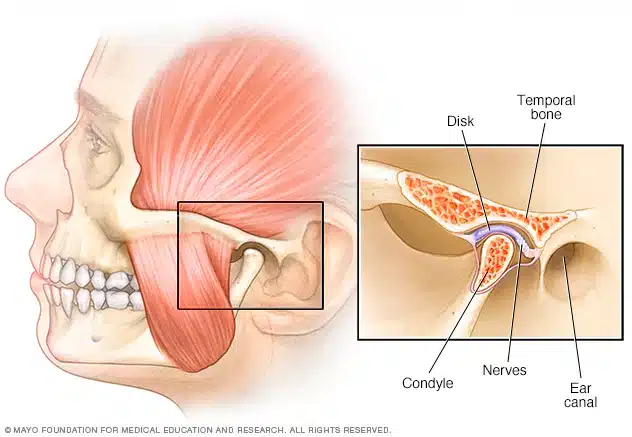Temporomandibular joint (TMJ) dysfunction, also known as TMJ syndrome or TMD, is a condition that affects the jaw joint and surrounding muscles. It can cause pain and discomfort, and can also affect how the jaw functions. In this blog, we will explore what TMJ dysfunction is, what causes it, and how it can be treated.
What is TMJ Dysfunction?
The temporomandibular joint is the hinge joint that connects the jawbone to the skull. It is responsible for the movement of the jaw, such as opening and closing the mouth and chewing. TMJ dysfunction is a condition that affects this joint and the surrounding muscles. It is characterised by pain or discomfort in the jaw, face, neck, or ears, as well as difficulty in opening and closing the mouth.

What Causes TMJ Dysfunction?
There is no one specific cause, but rather a combination of factors that can contribute to the condition. Some of the common causes include:
– Teeth grinding or clenching: This can put pressure on the jaw joint and surrounding muscles, leading to TMJ dysfunction.
– Trauma: Trauma to the jaw, such as a blow to the face or whiplash, can cause TMJ dysfunction.
– Misaligned bite: If the teeth do not align properly, it can put pressure on the jaw joint and cause TMJ dysfunction.
– Stress: Stress can cause tension in the jaw muscles, leading to TMJ dysfunction.
What are the Symptoms?
The symptoms of TMJ dysfunction can vary from person to person, but some of the common ones include:
– Pain or tenderness in the jaw joint, face, neck, or ears
– Difficulty in opening or closing the mouth
– Clicking or popping sounds when opening or closing the mouth
– Headaches or migraines
– Earaches
– Tinnitus (ringing in the ears)
– Dizziness
How is it Treated?
There are several treatment options available, depending on the severity of the condition. Some of the common treatments include:
– Lifestyle changes: Avoiding hard or chewy foods, using heat or ice packs on the jaw, and practising relaxation techniques can help reduce the symptoms of TMJ dysfunction.
– Medications: Over-the-counter pain relievers, such as ibuprofen, can help reduce pain and inflammation.
– Physiotherapy: Exercises and stretches can help strengthen the jaw muscles and improve flexibility.
– Dental treatments: Dental treatments such as orthodontics or a bite guard can help realign the teeth and reduce pressure on the jaw joint.
– Surgery: In severe cases, surgery may be necessary to repair or replace the temporomandibular joint.
How Can Physiotherapy Help with TMJ Dysfunction?
Physiotherapy can be an effective treatment option. A physiotherapist can help assess the underlying causes of the condition and develop a personalised treatment plan to address the symptoms and improve overall jaw function.
Here are some ways physiotherapy can help:
- Manual Therapy: A physiotherapist can use manual therapy techniques to mobilise the TMJ and surrounding muscles, reducing pain and improving range of motion. This may include massage, trigger point release, and joint mobilisation techniques.
- Exercises: Specific exercises can help strengthen the muscles around the TMJ, improving overall jaw function and reducing pain. These exercises may include stretches and strengthening exercises for the jaw, neck, and shoulder muscles.
- Education: A physiotherapist can provide education on body mechanics to reduce stress on the jaw joint and surrounding muscles. They can also teach relaxation techniques to reduce muscle tension.
Overall, physiotherapy can be an effective treatment option for TMJ dysfunction. By addressing the underlying causes of the condition and improving jaw function, a physiotherapist can help reduce pain, improve mobility, and improve overall quality of life. If you are experiencing symptoms of TMJ dysfunction, consider seeing a physiotherapist to determine the best treatment plan for your individual needs.
https://the-movement-mill.au4.cliniko.com/bookings
Or contact us to talk about your options:
https://themovementmill.com.au/contact-us/

